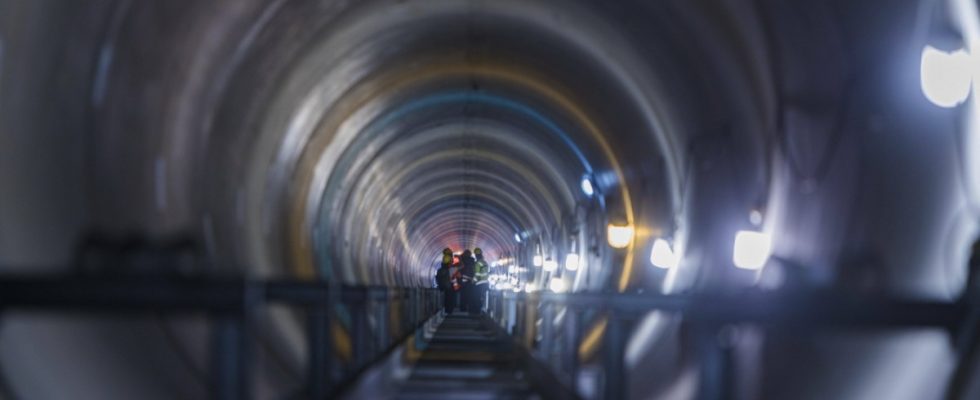There were difficult conditions under which Katharina Fegebank operated on the Dradenau peninsula on Thursday at ten o’clock: As the godmother of the tunnel boring machine Hermine, Hamburg’s second mayor had herself driven into a spacious shaft, 26 meters underground. Before their eyes is the colossus made of steel, weighing hundreds of tons. She was supposed to break a champagne bottle by loosening a rope structure, but two attempts failed. A quiet “Klonkkkk…” then the bottle rolled away. “It’s lying down there now,” said Fegebank disappointedly, but later the message reached her: The bottle finally shattered and the baptism was a success.
And so to the most important news: Hermine has been drilling since Thursday. According to Fegebank, it is “the symbol of the most important project of Hamburg’s energy transition”.
The construction project south of the Elbe is not an everyday one. Fegebank even discovered magical features in it through associations with the magician’s companion of the same name from Harry Potter: Hermione is supposed to drill a 1.16 kilometer long tunnel under the Elbe, 30 meters below the water. This is intended to create space for two district heating pipes. Warm water, which is produced by a new energy park at the harbor, then flows north under the Elbe. And cold water comes back again. More than 100,000 households are to be supplied by the tunnel lines, mostly in a climate-neutral manner. The coal-fired power plant in neighboring Wedel will then be unnecessary and is expected to be shut down at the end of 2025. This alone is expected to save up to 360,000 tons of CO₂ per year. “We can be a role model for other cities,” said Fegebank.
In fact, heat planning in many communities is not yet as advanced as in Hamburg. The port should also represent the energy transition here in the future. There are still “many and as yet unused climate-neutral heat sources lying dormant in the port area,” said Kirsten Fust. She is the technical managing director of Hamburger Energiewerke.
The route costs 280 million euros and weighs 670 tons
A big advantage is the density of local industrial companies, which release a lot of energy anyway. This means that waste heat from ArcelorMittal’s steelworks, a waste recycling plant and a sewage treatment plant can be used. It is to be bundled in a new energy park in the port with a gas and steam turbine power plant. Energy also comes from a wind-to-heat plant in Wedel that was inaugurated in the summer. “We want to be coal-free by 2030, if possible even by 2028,” said Environment Senator Jens Kerstan at the christening. As the last relic of the old days, the Tiefstack coal-fired power plant is to be shut down.
It costs 280 million euros to build the route. And it will take around a year until the drill reaches the other end of the tunnel in the Othmarschen district. Just putting Hermione together is a feat of strength. The diameter of the drill shield is 4.5 meters wide. The further it works through the ground, the longer Hermione becomes. Components will be added little by little, and its full length will ultimately be 280 meters. Her weight: 670 tons.
To ensure that the work runs smoothly, those responsible organized a priest according to mining customs. He then carried out the baptism on Thursday. A lot of effort for a machine, but just how delicate large construction projects can be, was shown on Monday by an accident in Hafen City in which four construction workers died. “May your service be a blessing for the people of Hamburg,” said Pastor Sieghard Wilm. He blessed not only Hermione, but also Saint Barbara, who is considered the patron saint of miners. She was then given her own place in the shaft.

